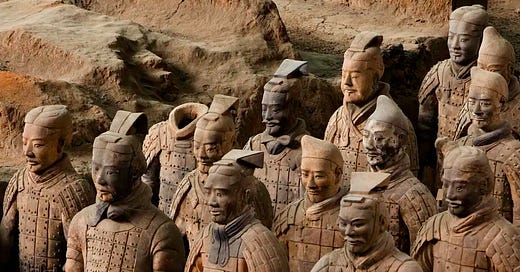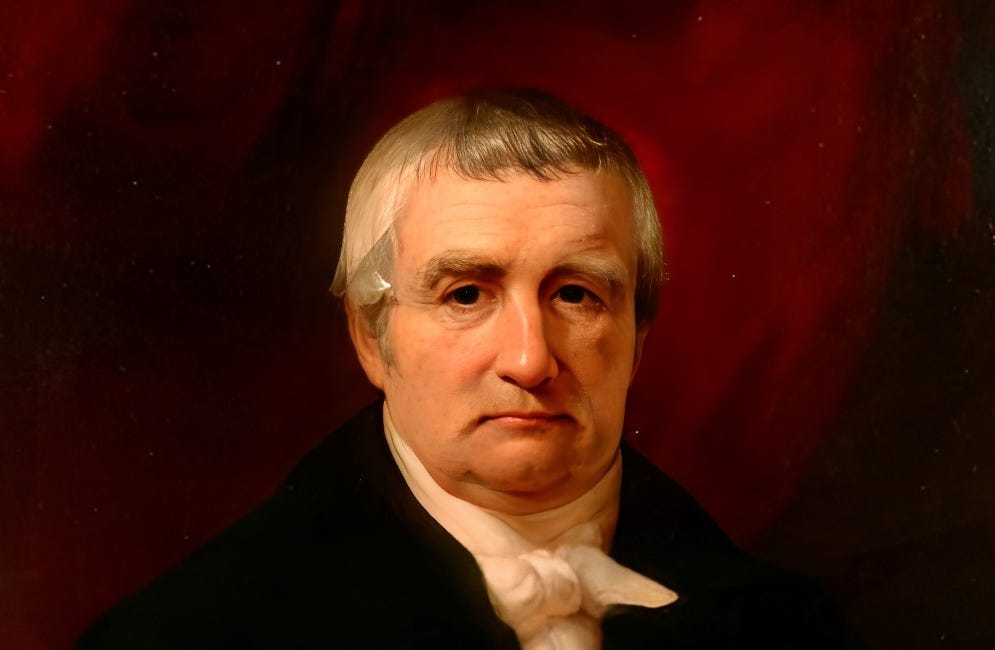March 29 - Forgotten Warriors: The Simple Dig That Revealed a Massive Chinese Clay Army
When God Withholds the Full Story
This is the day Chinese farmers discovered the Terracotta Army near Xi'an in 1974.
In today's lesson, we explore how Emperor Qin's still-sealed burial chamber parallels God's divine restraint in our spiritual lives. What if God's silence isn't abandonment but protection? What treasures might He be preserving by not revealing everything to us before we're ready to receive it?
"The secret things belong to the LORD our God, but the things revealed belong to us and to our children forever, that we may follow all the words of this law." - Deuteronomy 29:29 (NIV)
This Date in History
Local farmer Yang Zhifa's shovel struck something hard beneath the parched soil of Shaanxi Province. He paused, calling to his brothers working nearby. As they carefully scraped away the earth, fragments of a clay figure emerged—an ancient warrior's face staring back at them after more than two millennia of darkness. The farmers had stumbled upon what would become one of archaeology's greatest treasures: an underground army of thousands of life sized terracotta soldiers, each with unique facial features, standing in silent formation as they had for over 2,200 years.
The clay sentinels guarded the tomb of Qin Shi Huang, the ruthless and visionary ruler who conquered warring states to become China's first emperor in 221 BCE. His short but transformative reign unified China's written language, currency, and measurements while connecting defensive walls into what would become the Great Wall. Historical records described him as brilliant but paranoid, obsessed with finding immortality while brutally suppressing dissent. According to ancient historian Sima Qian, over 700,000 forced laborers constructed his elaborate mausoleum complex, many perishing during the monumental undertaking.
The terracotta warriors represented just one component of an underground kingdom spanning nearly 38 square miles. Historical records mentioned rivers of mercury flowing through the emperor's main burial chamber, with a ceiling studded with pearls representing the cosmos. Modern testing has confirmed abnormally high mercury levels in the soil above the unexcavated tomb. The elaborate complex reflected Qin's determination to rule as powerfully in death as in life.
Each warrior required extraordinary craftsmanship. Artisans constructed them using molds for bodies and limbs while individually sculpting faces, resulting in an army where no two soldiers are identical. Archaeologists believe a single figure required the work of several skilled craftsmen over weeks. The army included infantry, cavalry, archers, and charioteers organized in precise military formation, revealing the sophisticated military organization that helped Qin conquer China. Originally, the figures were painted in vibrant colors with real weapons—bronze swords, spears, and crossbows, many still sharp when discovered.
The manufacturing scale staggers modern observers. Excavations have uncovered approximately 8,000 soldiers, 130 chariots, 670 horses, and thousands of real bronze weapons. Specialists estimate hundreds of workshops and thousands of artisans labored for decades to complete the army. Workers stamped their names on completed pieces, allowing archaeologists to track individual craftsmen's output. This massive undertaking rivals Egypt's pyramids in scale and ambition, though occurring two millennia after Tutankhamun's burial.
The army's purpose connected to Qin's spiritual beliefs and imperial ambitions. Ancient Chinese custom held that objects buried with the dead would serve them in the afterlife. As emperor, Qin required protection on an unprecedented scale. Previously, living servants were sacrificed in royal tombs, but Qin's terracotta substitutes represented a more humane evolution of burial practices while maintaining impressive intimidation value. After completion, the figures were arranged in underground wooden corridors, then covered with layers of dirt and eventually forgotten as the Qin dynasty collapsed just four years after the emperor's death.
The discovery transformed our understanding of ancient Chinese civilization. The warriors revealed unprecedented details about Qin dynasty military organization, armor design, weapons technology, and artistic capabilities. The variations in uniform and positioning offered insights into military rank structures and battle formations. Trace elements in the clay helped archaeologists identify the location of ancient workshops and resource networks. Most significantly, the find confirmed historical accounts of Qin's grandiose burial preparations that scholars had previously considered exaggerated.
For Yang Zhifa and his fellow farmers, the discovery reshaped their lives. Initially paid just 10 yuan for reporting the find, they later worked as excavation assistants and eventually as museum staff. Yang spent years signing autographs for visitors at the museum gift shop before passing away in 1997. The site itself has become one of China's most visited attractions, drawing millions of visitors annually to the three excavation pits where archaeologists continue their painstaking work. Meanwhile, the emperor's actual tomb remains sealed, awaiting future archaeological techniques that can address its preservation challenges.
Historical Context
China's Qin dynasty emerged during a turbulent period known as the Warring States Era (475-221 BCE), when seven major states fought for dominance. This era saw intense military innovation, philosophical development, and economic change. The state of Qin, located in western China, implemented aggressive reforms that transformed it into a formidable military power. When Qin Shi Huang ascended the throne at age 13 in 246 BCE, he inherited a kingdom already poised for expansion.
The discovery of the Terracotta Army occurred during a pivotal time in Chinese history. The early 1970s marked a significant shift as China was emerging from the isolation and turmoil of the Cultural Revolution. Under Chairman Mao Zedong's leadership, ancient artifacts and historical sites had faced destruction as symbols of China's feudal past. However, by 1974, the Chinese government had begun recognizing the value of its historical heritage. The Terracotta Army discovery coincided with improving diplomatic relations with the West, particularly following US President Nixon's historic visit to China in 1972. This timing helped transform the archaeological find into not just a national treasure but also a powerful symbol of Chinese cultural heritage on the world stage.
Did You Know?
The terracotta warriors were equipped with actual functioning crossbows and other weapons. When tested, the bronze arrowheads could still penetrate multiple armor layers, demonstrating remarkable metallurgical knowledge for 3rd century BCE.
Though thousands of warriors have been excavated, experts estimate that up to 8,000 remain buried. Current excavation techniques proceed slowly to preserve the fragile artifacts, meaning future generations will continue discovering new aspects of the site.
Each warrior was fired in pieces in large kilns at temperatures exceeding 1000°C, a remarkable technological achievement for its time. The separate components were assembled using clay slips as adhesive, allowing for mass production while maintaining individual character.
The terracotta figures originally held real wooden weapons including swords, spears, and crossbows. While the wood decomposed long ago, the weapon shapes left impressions in the soil that archaeologists have been able to study and reconstruct.
Emperor Qin's tomb itself contains innovative engineering to prevent intrusion. According to historian Sima Qian's records, the tomb included mechanical crossbows designed to shoot anyone attempting unauthorized entry and complex waterways with flowing mercury. These details have been partially supported by modern geological surveys indicating high mercury levels around the tomb mound.
Today’s Reflection
In 1974, farmers digging a well in China's Shaanxi province struck something ancient just beneath the surface: fragments of an army made of clay. What they uncovered was not merely a historical monument, but a buried kingdom—thousands of life-sized terracotta warriors silently standing guard over the tomb of China's first emperor. And yet, despite half a century of excavation and advanced technology, the emperor's actual burial chamber remains sealed. Archaeologists know where it is. They've mapped it. But they refuse to open it—not because they can't, but because to do so could destroy what's inside.
That choice—to wait, to withhold, to let the tomb remain sealed—may seem like hesitation. But it's actually preservation. The chamber's contents are so fragile that exposure itself could cause irreparable harm.
That's where the spiritual insight lives.
God, too, is a Master of sealed tombs.
We often equate divine silence with divine absence. If God hasn't explained our suffering, revealed our next steps, or answered the question we've been asking for years, we assume He's either distant or uninterested. But Scripture paints a different picture. "The secret things belong to the LORD our God, but the things revealed belong to us…" Deuteronomy 29:29 (NIV)
Some things remain hidden because God is not just revealing truth—He is preserving glory.
There are seasons in our lives when we cry out for answers and receive none. We want to know the "why" behind the waiting. We beg for details about the future. We demand closure for the past. But God, in His mercy, sometimes keeps things sealed—not to punish us, but to protect the very things we're desperate to uncover.
If God showed you everything you asked for—every detail of your calling, every twist in the road ahead, every purpose behind your pain—could you carry it? Or would it collapse under the weight of your current maturity?
Some truths are too weighty to be unearthed too soon. Some blessings require the slow development of spiritual infrastructure before they can be safely revealed.
Jesus once told His disciples, "I have much more to say to you, more than you can now bear." John 16:12 (NIV) He wasn't hiding information out of reluctance—He was waiting out of love. He understood that timing and truth must travel together.
It's a hard thing to accept: that God might be delaying revelation not because it isn't real, but because we're not ready. Or because the conditions that would allow us to hold it without damaging it—faith, maturity, humility—are still being formed.
When God delays revelation, He's not holding something back from you. He may be holding it together for you.
This kind of waiting requires a deeper faith. A quieter trust. It demands that we believe not only in what God has said, but in what He has not yet chosen to say.
Spiritual maturity means honoring what God keeps sealed. It means resisting the temptation to pry open the unknown. It means believing that if God is silent, there's something worth protecting on the other side of that silence.
We want God to disclose everything. But God invites us into something better: to live well with the tension of partial revelation. To obey without full explanation. To trust that if the tomb remains closed, it is not because the treasure isn't real—but because the time to behold it has not yet come.
So ask yourself gently: What are you trying to force open in your spiritual life? What hidden thing do you feel entitled to uncover? And what if the silence you resent is actually the mercy you need?
God seals some things not to keep you in the dark, but to keep you in the light long enough for your soul to grow strong enough to receive the dawn.
Practical Application
Create a personal inventory of your "sealed tombs"—those areas where God seems silent or questions remain unanswered. For each one, write not just the question itself, but what might happen if you received the answer prematurely. Then beside each, write what spiritual quality might need development before that revelation would be beneficial rather than harmful. This exercise shifts focus from demanding answers to developing the character needed to receive them well. Throughout the week, practice saying, "Lord, I trust your timing with this sealed place in my life," whenever impatience for answers surfaces.
Closing Prayer
Heavenly Father, we thank You for Your perfect wisdom in revealing and concealing. Forgive us for the times we've demanded answers when You've offered relationship instead. Help us recognize that Your silence is not absence but often protection, preserving what we cannot yet steward. Develop in us the spiritual maturity to trust You with the sealed places in our lives. Create in us patient hearts that honor Your timing, believing that what remains hidden is held securely in Your hands. May we find peace in partial revelation, learning to walk by faith when we cannot see the full picture. In Jesus' name, who revealed the Father perfectly in His time, we pray. Amen.
Final Thoughts
God's silence is not His absence but His artistry in progress. Like a master painter who doesn't explain each brushstroke while creating, the Lord works purposefully through seasons of quiet. When answers seem withheld, remember that revelation requires preparation. What we mistake for divine hesitation is often divine cultivation, developing in us the capacity to receive truth without being crushed by its weight. Trust that whatever God keeps sealed today is not lost but preserved—protected until the perfect moment when both the revelation and your readiness to receive it converge in His perfect timing.
THIS IS THE DAY Last Year
March 29 - The Original American Tycoon: John Jacob Astor's Life of Fortune
This is the day John Jacob Astor, the first multi-millionaire businessman in the United States, died in 1848.
Author’s Notes
As a child, I was endlessly fascinated by the Terracotta Army. I’ll admit, I haven’t kept up with recent discoveries, so diving into research for today’s post was a real joy. What struck me most is how much of the site still lies buried. At the pace excavations are moving, it’s unlikely I’ll see it all uncovered in my lifetime. Yet even what's been revealed is staggering. The scale, precision, and sheer vision behind it are almost beyond belief. It’s a powerful reminder of what human beings can accomplish when their energy, imagination, and will are focused on a single purpose.
On a quick side note, I'm experimenting with the titles of these articles. Since most of you read them via email, I’m testing shorter subject lines that highlight the historical topic of the day more clearly. The usual titles are designed with discovery in mind—mainly for non-subscribers browsing through the Substack app. I’m trying to find the right balance between clarity and reach. If you have thoughts or experience with this kind of thing, I’d love to hear your perspective.
This devotional is free to read. You can support this publication by becoming a subscriber, upgrading to paid subscriber status, liking (❤️) this post, commenting, and/or sharing this post with anyone who might enjoy it. You can also make a ONE-TIME DONATION in any amount. Thank you for your support!













I lean unto God and not my own understanding. Proverbs 3:5. I remember that God provides all that we NEED on a day by day basis and that He always upholds us by His righteous right hand. 🙌🏻 Isaiah 41:10. I thank God for everything good and for working bad things for our good.
God knows all and knows best. To want to know everything is the human trait of controlling things ourselves, which delays or stops the work that God is doing. It is for our best to completely let God take over, otherwise we don't have His unlimited power working on our behalf. What a loss!
I see all differently now - ancient civilizations that, no matter how technically advanced, they were Godless - worshipping multiple manmade gods or believing that the human rulers were themselves gods.
It appears? there were no "Hebrews" in the far east, no one who remembered God the Creator of all. Manmade religions based on human gods filled the void. No matter how awe-inspiring our technical developments, it will all return to dust. No armies of warriors to protect them in an afterlife. Interesting thing the Godless civs all have in common: only the gods and rulers have an afterlife, everyone else is doomed to en sl ave ment. 🤔 Jesus tried to teach us that was not true, we are all God's children. Believing in God and knowing that Jesus is His Son has a far better outcome! The harvest is great.
As my Irish friends would stay “ f—king brill! I mean no offense by saying that Father Greely once said “ there are no swear words in Gaelic . They have taken to our Anglo- Saxon ones readily and mean no harm by it.” God bless